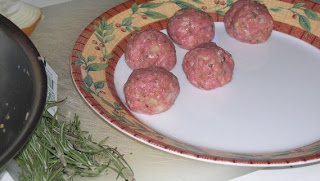But this week I have something else. I have Veal Meatball Marsala. I love marsala. It’s a different kind of love then the one I have for mac and cheese. That’s more of a lusty relationship. But marsala, I want to bring marsala home to meet my parents, but only to special occasions like Thanksgiving and Easter. Not to the everyday dinners and foibles of a family.
But on one of the first dates Joe and I ever went on, we ate at a restaurant in Washington DC called Grillfish. And I got monkfish marsala, which was a special for that evening. (I know, because I looked for it unsuccessfully every subsequent time thereafter). Which made me think, that maybe you could ‘marsala’ anything. You know, make a bet , dress it up, teach it how to speak, and then bring it out. With a little work, maybe I could My Fair Marsala anything!
Honestly, though, I only stuck to the standards. Until yesterday. When I was grocery shopping, I found ground veal on sale. It was such a good price that I couldn’t pass it up. But I was at a loss for what to make with it. That’s when I thought – Meatballs! This recipe makes a great weeknight meal that feels a little fancy. It’s the makeover movie for unlocking ground veal’s hidden beauty – with marsala!
Veal Marsala Meatballs
For the Meatballs
1 lb ground veal (although I bet chicken or turkey would be fine too)
1/3 c breadcrumbs
1 clove garlic, finely chopeed
½ small onion, finely chopped
2 Tb rosemary, finely chopped
1 egg
Salt and pepper to tatse
For the Sauce
½ onion, sliced
2 cloves garlic, diced
2/3 c dry marsala wine
1 c chicken stock
1 Tb rosemary, roughly chopped
1/3 c heavy cream
1 10oz. bag spinach, thoroughly washed
1. Mix all of the ingredients together for the meatballs. Roll into 1 – 1 ½” meatballs.
2. Heat 2 tablespoons of oil in a large sauté pan over medium high heat. Place meatballs in pan, but don’t crowd the pan, sauté in two batches if needed. Brown on all sides. Then remove to a plate.
3. Add spinach to remaining oil in pan and cook until just barely wilted. Sprinkle with salt, to preserve color, and remove t another plate.
4. While keeping pan on heat, add more oil if needed and onions and garlic. If there is some spinach water left in the pan, that’s fine. Sauté until onions are translucent, about 3 minutes. Then add the meatballs back to the pan. Add in marsala, chicken stock, and rosemary, reduce heat and simmer, covered for about 20 minutes.
5. After 20 minutes, remove lid and continue simmering for another 10 minutes. Season with salt and pepper. Just before serving add in cream to help thicken the sauce.
6. Meanwhile cook whatever pasta you want to serve this over.
7. To serve, place pasta on a plate or bowl, add spinach on top of pasta, then spoon meatballs and sauce over everything.
















